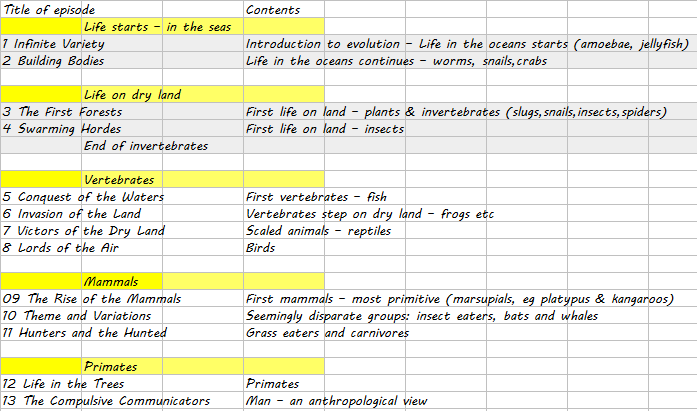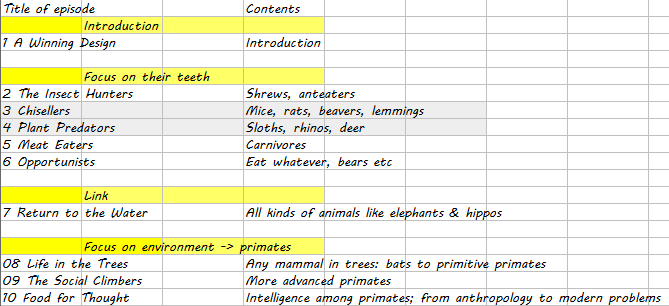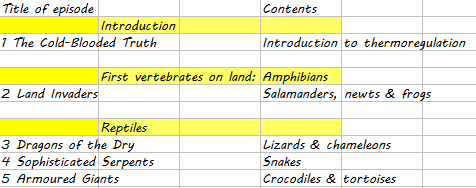series
INTRODUCTION
For the title Life Collection you might think there should be only one simple definition. The box set having been produced twice (the second version included material that had not been released by the time the first one was produced (in 1990).
All the series have two factors in common; they are all presented by Attenborough and they all have a companion book, but therein lies the problem. Apart from the series Life in the Freezer all books were written by Attenborough, this one was written by Alistair Fothergill. Attenborough only wrote the foreword. On those grounds it is left out of the collection and treated in a different category.
It could also be pointed out that it is the only geographical series, but on the same grounds the plants series could be objected to. Similarly this series is the only one consisting exclusively of 30 minute episodes, the rest of the box set are of the normal 50+ minute length.
After finishing the collection Attenborough joined forces with Matt Kaplan for a two part series, concentrating on technical advances since the start of the collection. This series he seemed to regard as the final installment for the collection even though he neither wrote the programmes nor the accompanying book.
Being highly thematic, the first three series are, logically, regarded as a trilogy. The first Life on Earth, deals with evolution. The second The Living Planet, deals with ecology and the last one The Trials of Life is about the science of behaviour, ethology.
The rest of the collection covers various groups of living organisms starting with The Private Life of Plants followed by various animal groups (Life of Birds, Life of Mammals, Life in the Undergrowth, and finally Life in Cold Blood). The last of these was released after the Life Collection box, but was included in its re-release (2018).
Setting the standards
At the beginning of production of Life on Earth Attenborough’s team decided that all the sequences they were about to film would be unique, they would prefer animals not previously seen on television or show them in a new light, people should see something new in every case. Since there were to be more series to follow this would apply to all of them.
As clearly mentioned in his memoirs, making such a big series which occupies several years for a large team had its obvious benefits: it is economically feasible to include brief glimpses from various distant places. Attenborough could in one place finish talking about something he started some years ago in another. This was quite new for television and can in fact be taken to mean various different things: Does he show up or merely speak from the studio but the scenes take place in different places? The best example seems to be found in their USA tour explained by Parsons detailing all its complications filming sequences for most of the programmes in the series. While a laboratory sequence was being filmed explaining the importance of microscopic fossils found in the Great Lakes (episode one) Attenborough was filming dolphins in Florida.
In each series every programme was assigned its own producer but all the team discussed and debated the scripts written originally by Attenborough. As he had finished a particular script every part of it was checked and, if necessary modified by going straight to the expert in that subject area. This was done by correspondence, a telephone call or (very often) visiting the experts wherever they where in the world. The animal and plant species that Attenborough proposed as examples were naturally those familiar to him but expected research to lead to better examples as would sometimes be the case.
Sometimes the scripts might even change due to recent, but yet unpublished, work (as in Life in the Trees episode chimpanzees were replaced with gorillas). Since this is not necessarily meant to be an exhaustive list only a couple of such examples will be given (actually in the ‘Trials’ series where enough information was given in his memoirs) suggestive of the labour of love given to the project and how even professionals could enjoy its ‘up-to-dateness’.
Attenborough, naturally couldn’t be too specific about each shot but gave at times rather a detailed information of what was needed. Having very experienced cameramen in the field these details could be left to them because the animals don’t read scripts, like human actors do. There should be no over-dramatisation of the sequences, and in order to make sure they would stay as true to the subjects as possible the film was first shown to the scientists responsible and only brought to the final version after their approval.
Becoming such a grandiose a scale BBC even for a while considered that “Life on Earth” was becoming such drain on their manpower and finances that it should preferably be outsourced. Instead of doing so they, however, managed to get Warner (Brothers?) as co-producer s. Otherwise this would raise the question what would otherwise have happened.
Further reading:
Ed Yong (2016). The Atlantic. Every Episode of David Attenborough’s Life Series, Ranked. A different but great piece about Attenborough written on the eve of Attenborough’s 90th birthday.
Life Collection in Retrospect
Life Collection is a boxed set of wildlife series covering the life on our planet. In the writings piece there is a comment pointing out that one series in the box set, Life in the Freezer, is exceptional in the accompanying book not having been written by Attenborough. It will therefore be ignored here. The rest of the series will be included.
The lists for each series include the title of each episode and a brief description of its contents. This is necessary because even though the titles are good they may not be descriptive enough. Many of the descriptions were very straight forward, like those from Life on Earth. However in some thematic ones the description was based on the outline given for that particular episode.
The series tend to stick to what could be regarded as a pattern or framework, some format that suits the needs for both scientists and public.
THE TRILOGY
Life on Earth starts with an introduction to Charles Darwin and deals with one animal group after another, first following the invertebrates ending with insects. Then another story begins with vertebrates that leads to vertebrates that step onto land leading finally to an anthropological look at humans. This is all followed in the image below.

An overview of the Life on Earth series. In grey is the reign of the invertebrates.
This series was followed by Living Planet where there is the very involved story of water and its accessibility for living organisms. The series starts with an introductory programme on geology, how land was formed through volcanic activity and how life always returns to the otherwise sterile land. This is followed by several episodes about how latitude (from the poles to the deserts) affects it by being almost permanently frozen to evaporating instantly. The final part of the series involves the story of water changing from being fresh to getting salty and therefore inaccessible. These two stories are seamlessly connected by a single programme about the forces of gravity.

The Trials of Life deals with how animals overcome the many obstacles life throws at them. It starts at birth and ends at the age when an individual has grown up and gives birth to another generation.
The greyed areas in this and the following tables indicate factors the series have in common.

To most people these three series form a so-called trilogy, but that is as far as people usually go in grouping any of the series in the Life Collection.
SETTING THE NORM
The previous series are commonly set aside and treated as s separate entity. Each of them describes an important branch of biology. They are used to varying extent in later series either as biological “blueprints” or as “templates” for a way of story telling.
This thematic way of looking at animals actually forms a basis for not only the rest of the collection but also for most of the BBC blockbusters that were to come. Each programme was based on a particular environment and its inhabitants’ behaviour was the basis for the whole series.
Looking a bit more closely, many more similarities turn up: Trials of Life is the only series where there is absolutely no introduction to the rest of the series; it starts instantly with birth. All other series spend at least a few minutes of the first episode to introduce the theme. In some series it is more obvious than in others, probably most obvious being in the mammals and cold blood series.
In the whole collection only Trials and Life on Earth completely ignored the human impact on earth. All other series dealt with it, some more than others. In the mammals series only the final sentence does. In Living Planet and Birds series almost all of the last episode does.
THE REST OF THE COLLECTION
The Plants series could in certain ways be regarded as the plants’ version of the Trials of life. It obviously stands out as the only series dedicated not to animals. Apart from a definite start and end in the whole series there is no definite story line here. Rearranging the order of programmes could make a story line, but that might have made it resemble the previous one too closely for the team’s liking.

If the plant series had some references to the Trials series they were much more obvious in the birds series. The word ‘Life’ is very ambiguous and so can be used in many different ways. The title of the series Life of birds could more descriptively have been named ‘The Trials of being a bird’.

The series starts with not just one but two introductory episodes, the first one pointing out that not all birds fly. The second deals with how demanding it is to fly (which is why some birds simply don’t bother). This is followed by three episodes about how those who bother can find food. Actually the last twenty minutes of the second episode deals with waders feeding on the mud flats, therefore starting the feeding part of the series a bit prematurely. In the Trials there is only one episode on that subject but here is the first one on nuts and the like, the next on birds of prey and the last on fish as food. The rest of the series is about communicating and raising young similarly to matters dealt with in the Trials, but not in the same order.

The mammals series does relate somewhat to the birds series. The key to life is eating and the key to eating among mammals is having suitable teeth for the job. An animal without teeth will starve to death. After an introductory programme the main focus is on their teeth. Being also the way scientists deal with mammals, means that the story is actually being told in a similar way to Life on Earth (through natural history). This applies to the first 6 and the final 3 episodes, dealing with primates. Just like in Living Planet this series uses a single episode to connect these two stories while managing to cover all the major groups.
The final story is about the origin of primates. The final episode, like the predecessor, Life on Earth, deals with anthropology stretching a bit further into space and finishing off with a final sentence touching on the human impact on the planet, something omitted earlier.
Birds and mammals are very close to us humans and therefore a rather large series is dedicated to each group. The same cannot be said about the final two series that may have been produced mainly to fill in the final gaps.
The Undergrowth series is mainly about the insects, using other invertebrates as an introduction. It does bear resemblance to episode 3 from Life on Earth series. These are disparate programmes but a seemingly obvious story line.

Finally there was a series about Life in Cold Blood, about reptiles and amphibians (not in this order naturally).

Vitally, this series starts with an introduction to what it means to have cold blood. This is followed by a single programme on amphibians. Ironically this is a shorter coverage than they got in the Life on Earth series because here a 10 minute final piece is always dedicated to a look behind the scenes. The series ends with three programmes on reptiles which is obviously a lot more than the time dedicated to them earlier.
As may stand out the last two series as well as the plant series stand out as being much shorter 5-6 programmes than any of the other.
Finally it must be noted that the order of series benefitted from advances in filming technology discussed elsewhere. Only the last series included ‘behind the scenes’ sequences.
If the first two series after the trilogy seemed to be treated in a similar way to the Trials series, then the last three were treated more like group by group, similarly to Life on Earth.